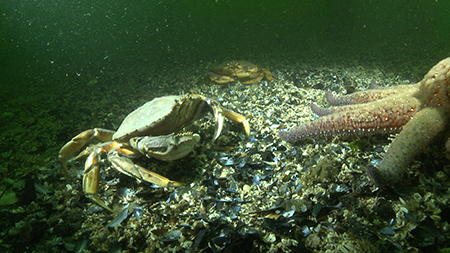
Sea Wonder: Dungeness Crab

Photo credit: Paul Hillman/NOAA
Dungeness crab is a valuable species throughout the national marine sanctuaries of the West Coast from Washington state to throughout California.
Appearance
The Dungeness crab is a species of crustacean that looks exactly like how we would expect a crab to look like. It is oblong in shape; has a wide, brown, yellow, or purple-hued shell; five pairs of legs (four pairs for walking and the front pair includes claws for grabbing and defense); eyes and antenna at the front of its shell; and its gills and mouth openings on the underside of its body. Fully grown, the Dungeness crab can reach a carapace (shell) width of 6.5 inches and weigh up to three pounds on average. Adult males are often larger than adult females.
Habitat
Dungeness crabs got their name from the town of Dungeness, Washington, where the commercial fishery for this species began in 1848. They thrive in cold water environments and live sandy environments like bays, inlets, and estuaries, including in seagrass beds and rocky structures. Their depth can range from very shallow intertidal waters to depths of about 800 feet. On average, they will inhabit waters no more than 150 feet deep and that are near strong currents.
Dungeness crabs are naturally found in the Pacific Ocean and span three countries: Canada, the United States, and Mexico. We can most commonly find Dungeness crab populations between the Aleutian Islands in Alaska and Santa Barbara, California, but we occasionally see them as far south as Baja California Sur in Mexico. This means Dungeness crabs call Olympic Coast, Monterey Bay, Cordell Bank, Channel Islands, and Greater Farallones national marine sanctuaries home.
Diet & Life History
They mate in the spring and summer and up to 2.5million eggs develop through the fall on each female’s underside. When it’s time to give birth, females release the eggs into the water column where they hatch and swim freely away from their mothers or are carried away by the current.
Dungeness crabs are typically born in the winter months as zoea larvae that spend between three and six months growing through five life stages before they become megalopa larvae. They then become more crablike in appearance and settle into a habitat as they progress to the juvenile life stage between one and two years of age. Adult status is reached at about two years of age, and the lifespan of a Dungeness crab averages about six years.
Given Dungeness crabs are invertebrates with exoskeletons (shells), they cannot grow freely. They have to shed their shells annually until they reach their full size in a process called molting. During the molting process, the crab’s hard shell (including the crab’s old gills, antennae, and mouth) peels off, leaving behind a softer, more vulnerable (but larger) shell. The shell solidifies in a few weeks and the process starts all over the following year. Crab molts are quite common on west coast beaches.
Dungeness crabs are preyed upon by fish, octopus, sea otters, and even larger species of crab, and they eat worms, shrimp, mussels, smaller crabs, clams, and anything else they can find. Dungeness crabs are safe for people to eat and provide for the West Coast’s most valuable commercial fishery, valued at more than $170 million annually!
Threats and Conservation
Ocean acidification is one of the largest threats facing Dungeness crabs and the associated commercial fishery. A more acidic ocean environment prevents remineralization of the Dungeness crab’s shell, leaving freshly molted crabs especially vulnerable with their soft shells for longer periods of time. This phenomenon could also have impacts on the Dungeness crab fishery, which already stops fishing for the crabs during molting season between August and early December due to their fragility in their soft-shell state. As the ocean acidifies, the fishery may have to close down for longer and fewer individual crabs may reach adulthood or full size.
Management within national marine sanctuaries, as well as research and education programs help contribute to the health, well-being, and knowledge of the species and its habitats. Dungeness crabs are considered a sustainable source of seafood due to population and fishery management and the methods of fishing used to retrieve them.
Learn more about Dungeness crabs and ocean acidification from NOAA by clicking here.
